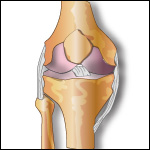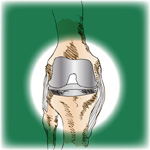Black/White Disparity in Knee Replacements
 The number of total knee replacements in the United States increased between 2000 and 2006, but without any reduction in the black/white disparity. The rate of this important intervention to reduce pain and disability continues to lag for blacks compared to whites.
The number of total knee replacements in the United States increased between 2000 and 2006, but without any reduction in the black/white disparity. The rate of this important intervention to reduce pain and disability continues to lag for blacks compared to whites.

A normal knee
Nearly half of American adults may develop symptomatic knee osteoarthritis in at least one knee over their lifetime, with an equal risk of this disabling condition among whites and blacks. Total knee replacement is an effective method of reducing pain and improving physical function among those with disabling knee osteoarthritis, but whites have been more likely to undergo the procedure than blacks.
Recognizing the substantial public health impact of this disparity, the Healthy People 2010 working group adopted objective 2.6, "Eliminate racial disparities in the rate of total knee replacement among persons age 65 years and older." CDC studied national and state-specific total knee replacement rates for 2000-2006 Medicare enrollees to provide the first tracking [1] of this objective.
The national total knee replacement rate increased by 58% from 2000 through 2006, with an increase of 61% among whites and an increase of 56% among blacks. However, the black/white disparity persisted; the rate for blacks was 37% lower than whites in 2000 (3.6 vs. 5.7 per 1,000) and the rate for blacks was 39% lower in 2006 (5.6 vs. 9.2 per 1,000).

Knee with joint replacement
In 2006, blacks had a lower rate of total knee replacement than whites in every state and the District of Columbia (D.C.). The smallest state-specific black/white difference in total knee replacement rates was documented in D.C. (11%), Massachusetts (18%), and Delaware (18%). The largest black/white gap was in Illinois (52%) and Pennsylvania (49%). Between 2000 and 2006, the black/white gap increased across all three age groups, among women but not men, and in 19 of the 50 states and D.C.
Read more about this CDC study.
[1] Cisternas MG, MGC Data Svcs, Murphy L, Croft JB, Helmick CG. Racial Disparities in Total Knee Replacement amongMedicare Enrollees — United States, 2000–2006. MMWR 2009;58(6):134-8.
More Information
Current Features
Need info on a
different topic? See


